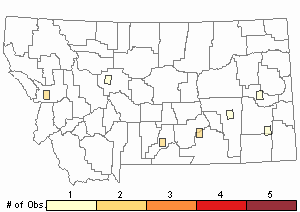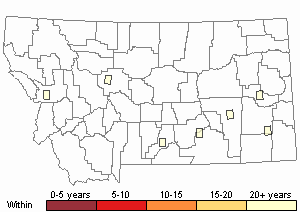View in other NatureServe Network Field Guides
NatureServe
Montana
Utah
Wyoming
Idaho
Wisconsin
British Columbia
South Carolina
Yukon
California
New York
Striped Sand Grasshopper - Melanoplus foedus
General Description
The following is taken from Brooks (1958), Vickery and Kevan (1985), Pfadt (2002), Capinera et al. (2004), Capinera and Sechrist (1982), Brust et al. (2008, 2010), and Scott (2010). Body color is generally brownish yellow to red brown, but variations occur among populations depending upon habitat background and even biogeographic range. A dark stripe runs over the head and onto the center of the pronotum and is bordered on each side by pale stripes. The dark stripe can sometimes be absent. The tegmina (wing) is long, extending beyond the abdomen tip. The outer surface of the hind femur is dark dorsally and pale ventrally. The inner face is light orange-brown or pale. The hind tibia is commonly red but can be blue at northern latitudes.
Phenology
This is an early hatching species, nymphs appearing in early spring, ranging from May 1 to 29. Adults occur from early July to October (Pfadt 2002).
Diagnostic Characteristics
The body length to end of forewings for males is 22 to 26 mm, and for females 26 to 34 mm. More positive diagnostics require examining the male aedeagus (Brooks 1958, Vickery and Kevan 1985, Pfadt 2002, Capinera et al. 2004, Capinera and Sechrist 1982, Brust et al. 2008 and 2010, and Scott 2010).
M. foedus has been considered as three subspecies in many texts:
M. foedus foedus,
M. foedus fluviatilis, and
M. foedus isleyi. It is often confused with
Packard’s Spurthroat (
M. packardii) and
M. fluviatilis, which are now considered recognized species. These 3 species are in what is termed as the “Melanoplus packardii group.” Essentially, these 3 species are truly “look-a-likes” in that the male genitalia are nearly identical.
M. foedus tends to be slightly larger and lighter in color than
Packard’s Spurthroat (
M. packardii). It can also be confused with the
Narrow-winged Grasshopper (
M. angustipennis) (Brust et al. 2008 and 2010, and Capinera and Sechrist 1982).
Refer to the Pictorial Key to the “Melanoplus packardii Group" above for identification assistance.
Species Range
Montana Range
Range Descriptions

 Native
Native
Range Comments
The following comes from Vickery and Kevan (1985), Pfadt (2002), Capinera et al. (2004), Capinera and Sechrist (1982), Brust et al. (2008 and 2010), and Scott (2010). The Striped Sand Grasshopper is a western species, occurring from the Mississippi river to the Pacific coast states and southern British Columbia, Canada and from southern Alberta, Saskatchewan and Manitoba, southward into Arizona, New Mexico, and Texas. Its range is nearly coextensive with that of Packard’s Spurthroat (M. packardii), which it closely resembles. In Montana, this species has been confirmed in 14 counties.
Observations in Montana Natural Heritage Program Database
Number of Observations: 10
(Click on the following maps and charts to see full sized version)
Map Help and Descriptions
Relative Density

Recency


 (Observations spanning multiple months or years are excluded from time charts)
(Observations spanning multiple months or years are excluded from time charts)
Habitat
Inhabits sandy grasslands of uplands (grasslands/prairies) and river bottoms. Over its large geographical range, it does not generally occupy the same habitats as
Packard’s Spurthroat (
M. packardii) (Pfadt 2002,
and Capinera and Sechrist 1982).
Food Habits
This species prefers a wide diversity of forbs but does feed on grasses and sedges. Some studies indicate that its diet consists of 56 species of forbs, 19 species of grasses and 2 species of sedges (Pfadt 2002, Capinera and Sechrist 1982).
Reproductive Characteristics
Females deposit eggs in sandy and semi-soft soils, often in cultivated grain fields, stubble fields, and old pocket gopher mounds. The egg pod can be variable in structure and contains 16 to 30 eggs arranged in two or three columns. Nymphs pass through 5 instars (Pfadt 2002, Capinera and Sechrist 1982).
References
- Literature Cited AboveLegend:
 View Online Publication
View Online Publication Brooks, A.R. 1958. Acridoidea of Southern Alberta, Saskatchewan, and Manitoba (Orthoptera). The Canadian Entomologist (Supplement 9) 90:5-92.
Brooks, A.R. 1958. Acridoidea of Southern Alberta, Saskatchewan, and Manitoba (Orthoptera). The Canadian Entomologist (Supplement 9) 90:5-92. Brust, M.L, W.W. Hoback, and R.J. Wright. 2008. The Grasshoppers of Nebraska. Lincoln, NB: University of Nebraska Extension Service, APHIS.
Brust, M.L, W.W. Hoback, and R.J. Wright. 2008. The Grasshoppers of Nebraska. Lincoln, NB: University of Nebraska Extension Service, APHIS. Brust, M.L., E.J. Landroth, W.W. Hoback, R.J. Wright, K. Hanford and J.E. Foster. 2010. Morphological and genetic analyses in the Melanoplus parckardii group. Journal of Orthoptera Research 19:281–288. doi: 10.1665/034.019.0215.
Brust, M.L., E.J. Landroth, W.W. Hoback, R.J. Wright, K. Hanford and J.E. Foster. 2010. Morphological and genetic analyses in the Melanoplus parckardii group. Journal of Orthoptera Research 19:281–288. doi: 10.1665/034.019.0215. Brust, M.L., W.W. Hoback, and R.J. Wright. 2008. A Synopsis of Nebraska Grasshopper Distributions. Journal of the Kansas Entomological Society 81(3):208-255.
Brust, M.L., W.W. Hoback, and R.J. Wright. 2008. A Synopsis of Nebraska Grasshopper Distributions. Journal of the Kansas Entomological Society 81(3):208-255. Capinera, J.L. and T.S. Sechrist. 1982. Grasshoppers of Colorado: Identification, Biology, and Management. Fort Collins, CO: Colorado State University Experiment Station, Bulletin 584S. 161 p.
Capinera, J.L. and T.S. Sechrist. 1982. Grasshoppers of Colorado: Identification, Biology, and Management. Fort Collins, CO: Colorado State University Experiment Station, Bulletin 584S. 161 p. Capinera, J.L., R.D. Scott, and T.J. Walker. 2004. Field Guide to Grasshoppers, Katydids, and Crickets of the United States. Ithaca, NY. Cornell University Press.
Capinera, J.L., R.D. Scott, and T.J. Walker. 2004. Field Guide to Grasshoppers, Katydids, and Crickets of the United States. Ithaca, NY. Cornell University Press. Pfadt, R.E. 2002. Field Guide to Common Western Grasshoppers, 3rd edition. Laramie, WY: Wyoming Agricultural Experiment Station, Bulletin 912, modified by S. Schell and S. Schell for electronic publication. Accessed 19 February 2020. http://www.uwyo.edu/entomology/grasshoppers/field-guide/index.html#fieldguidetoc
Pfadt, R.E. 2002. Field Guide to Common Western Grasshoppers, 3rd edition. Laramie, WY: Wyoming Agricultural Experiment Station, Bulletin 912, modified by S. Schell and S. Schell for electronic publication. Accessed 19 February 2020. http://www.uwyo.edu/entomology/grasshoppers/field-guide/index.html#fieldguidetoc Scott, R.D. 2010. Montana Grasshoppers, Katydids, and Crickets A Pictorial Field Guide to the Orthoptera. MagpieMTGraphics, Billings, MT.
Scott, R.D. 2010. Montana Grasshoppers, Katydids, and Crickets A Pictorial Field Guide to the Orthoptera. MagpieMTGraphics, Billings, MT. Vickery, V. R. and D. K. M. Kevan. 1985. The grasshopper, crickets, and related insects of Canada and adjacent regions. Biosystematics Research Institute, Ottawa, Ontario. Publication Number 1777. 918 pp.
Vickery, V. R. and D. K. M. Kevan. 1985. The grasshopper, crickets, and related insects of Canada and adjacent regions. Biosystematics Research Institute, Ottawa, Ontario. Publication Number 1777. 918 pp.
- Additional ReferencesLegend:
 View Online Publication
View Online Publication
Do you know of a citation we're missing? Hebard, M. 1928. The Orthoptera of Montana. Proceedings of the Academy of Natural Sciences of Philadelphia, Vol. 80:211-306.
Hebard, M. 1928. The Orthoptera of Montana. Proceedings of the Academy of Natural Sciences of Philadelphia, Vol. 80:211-306. Hebard, M. 1932. Notes on Montana Orthoptera. Proceedings of the Academy of Natural Sciences of Philadelphia. V. 84. pp 251-257.
Hebard, M. 1932. Notes on Montana Orthoptera. Proceedings of the Academy of Natural Sciences of Philadelphia. V. 84. pp 251-257. Kirk, K. and C.R. Bomar. 2005. Guide to the grasshoppers of Wisconsin. Madison, WI: Wisconsin Department of Natural Resources, Bureau of Integrated Science Services PUB-SS-1008. 154 p.
Kirk, K. and C.R. Bomar. 2005. Guide to the grasshoppers of Wisconsin. Madison, WI: Wisconsin Department of Natural Resources, Bureau of Integrated Science Services PUB-SS-1008. 154 p.
- Web Search Engines for Articles on "Striped Sand Grasshopper"
- Additional Sources of Information Related to "Insects"





